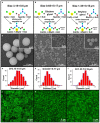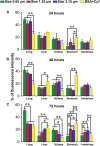Use of Submicron Vaterite Particles Serves as an Effective Delivery Vehicle to the Respiratory Portion of the Lung
- PMID: 29915536
- PMCID: PMC5994594
- DOI: 10.3389/fphar.2018.00559
Use of Submicron Vaterite Particles Serves as an Effective Delivery Vehicle to the Respiratory Portion of the Lung
Abstract
Nano- and microencapsulation has proven to be a useful technique for the construction of drug delivery vehicles for use in vascular medicine. However, the possibility of using these techniques within the lung as an inhalation delivery mechanism has not been previously considered. A critical element of particle delivery to the lung is the degree of penetrance that can be achieved with respect to the airway tree. In this study we examined the effectiveness of near infrared (NIR) dye (Cy7) labeled calcium carbonate (vaterite) particles of 3.15, 1.35, and 0.65 μm diameter in reaching the respiratory portion of the lung. First of all, it was shown that, interaction vaterite particles and the components of the pulmonary surfactant occurs a very strong retardation of the recrystallization and dissolution of the particles, which can subsequently be used to create systems with a prolonging release of bioactive substances after the particles penetrate the distal sections of the lungs. Submicro- and microparticles, coated with Cy7 labeled albumin as a model compound, were delivered to mouse lungs via tracheostomy with subsequent imaging performed 24, 48, and 72 h after delivery by in vivo fluorescence. 20 min post administration particles of all three sizes were visible in the lung, with the deepest penetrance observed with 0.65 μm particles. In vivo biodistribution was confirmed by fluorescence tomography imaging of excised organs post 72 h. Laser scanning confocal microscopy shows 0.65 μm particles reaching the alveolar space. The delivery of fluorophore to the blood was assessed using Cy7 labeled 0.65 μm particles. Cy7 labeled 0.65 μm particles efficiently delivered fluorescent material to the blood with a peak 3 h after particle administration. The pharmacokinetics of NIR fluorescence dye will be shown. These studies establish that by using 0.65 μm particles loaded with Cy7 we can efficiently access the respiratory portion of the lung, which represents a potentially efficient delivery mechanism for both the lung and the vasculature.
Keywords: drug carriers; prolonging release; pulmonary drug delivery; size-dependent biodistribution; vaterite particles.
Figures







Similar articles
-
Calcium carbonate vaterite particles for drug delivery: Advances and challenges.Mater Today Adv. 2022 Jun;14:100214. doi: 10.1016/j.mtadv.2022.100214. Epub 2022 Feb 12. Mater Today Adv. 2022. PMID: 36785703 Free PMC article. Review.
-
Vaterite submicron particles designed for photodynamic therapy in cells.Photodiagnosis Photodyn Ther. 2020 Sep;31:101913. doi: 10.1016/j.pdpdt.2020.101913. Epub 2020 Jul 6. Photodiagnosis Photodyn Ther. 2020. PMID: 32645435
-
Photodynamic therapy platform based on localized delivery of photosensitizer by vaterite submicron particles.Colloids Surf B Biointerfaces. 2016 Oct 1;146:171-9. doi: 10.1016/j.colsurfb.2016.05.090. Epub 2016 May 31. Colloids Surf B Biointerfaces. 2016. PMID: 27318962
-
Substance deposition assessment in obstructed pulmonary system through numerical characterization of airflow and inhaled particles attributes.BMC Med Inform Decis Mak. 2017 Dec 20;17(Suppl 3):173. doi: 10.1186/s12911-017-0561-y. BMC Med Inform Decis Mak. 2017. PMID: 29297393 Free PMC article.
-
CaCO₃ vaterite microparticles for biomedical and personal care applications.Mater Sci Eng C Mater Biol Appl. 2014 Dec;45:644-58. doi: 10.1016/j.msec.2014.04.050. Epub 2014 May 14. Mater Sci Eng C Mater Biol Appl. 2014. PMID: 25491874 Review.
Cited by
-
Calcium carbonate vaterite particles for drug delivery: Advances and challenges.Mater Today Adv. 2022 Jun;14:100214. doi: 10.1016/j.mtadv.2022.100214. Epub 2022 Feb 12. Mater Today Adv. 2022. PMID: 36785703 Free PMC article. Review.
-
Systematic comparison of methods for determining the in vivo biodistribution of porous nanostructured injectable inorganic particles.Acta Biomater. 2019 Oct 1;97:501-512. doi: 10.1016/j.actbio.2019.08.002. Epub 2019 Aug 3. Acta Biomater. 2019. PMID: 31386927 Free PMC article.
-
Exploiting Benefits of Vaterite Metastability to Design Degradable Systems for Biomedical Applications.Pharmaceutics. 2023 Nov 2;15(11):2574. doi: 10.3390/pharmaceutics15112574. Pharmaceutics. 2023. PMID: 38004553 Free PMC article. Review.
-
Porous Inorganic Carriers Based on Silica, Calcium Carbonate and Calcium Phosphate for Controlled/Modulated Drug Delivery: Fresh Outlook and Future Perspectives.Pharmaceutics. 2018 Sep 25;10(4):167. doi: 10.3390/pharmaceutics10040167. Pharmaceutics. 2018. PMID: 30257514 Free PMC article. Review.
-
Imaging drug delivery to the lungs: Methods and applications in oncology.Adv Drug Deliv Rev. 2023 Jan;192:114641. doi: 10.1016/j.addr.2022.114641. Epub 2022 Dec 9. Adv Drug Deliv Rev. 2023. PMID: 36509173 Free PMC article. Review.
References
-
- Atochina-Vasserman E. N., Gow A. J., Abramova H., Guo C. J., Kadire H., Tomer Y., et al. (2009). Immune reconstitution during Pneumocystis lung infection: disruption of surfactant component expression and function by S-nitrosylation. J. Immunol. 182 2277–2287. 10.4049/jimmunol.0802775 - DOI - PMC - PubMed
-
- Borodina T. N., Trushina D. B., Marchenko I. V., Bukreeva T. V. (2016). Calcium carbonate-based mucoadhesive microcontainers for intranasal delivery of drugs bypassing the blood–brain barrier. BioNanoScience 6 261–268. 10.1007/s12668-016-0212-2 - DOI
Grants and funding
LinkOut - more resources
Full Text Sources
Other Literature Sources
Miscellaneous

